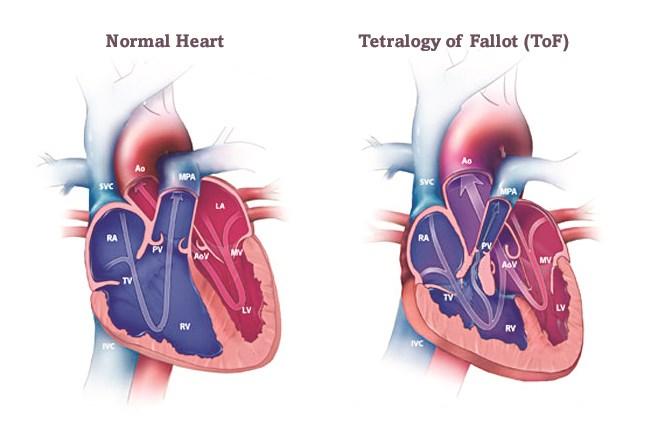
Tetralogy of Fallot (TOF) Repair: Restoring Normal Blood Flow in Cyanotic Heart Disease
Introduction & Overview
Tetralogy of Fallot (TOF) is one of the most common congenital heart defects and is classified as a cyanotic congenital heart disease. First described by Étienne-Louis Fallot in 1888, it is characterized by four anatomical abnormalities that affect blood flow through the heart, leading to oxygen-poor blood being pumped into the body. This results in cyanosis — a bluish tint to the skin and lips.
The four defining features of TOF are:
✔ Ventricular Septal Defect (VSD): A hole between the right and left ventricles.
✔ Pulmonary Stenosis: Narrowing of the pulmonary valve and right ventricular outflow tract.
✔ Overriding Aorta: The aorta is positioned directly above the VSD, receiving blood from both ventricles.
✔ Right Ventricular Hypertrophy: Thickening of the right ventricular muscle due to increased workload.
TOF Repair is a life-saving surgical procedure that corrects these defects, enabling the heart to pump oxygen-rich blood throughout the body. The surgery is typically performed in infancy, though timing can vary depending on the child's condition.
Types of TOF and Variants
✔ Classic TOF
✔ TOF with Pulmonary Atresia
✔ TOF with Major Aortopulmonary Collateral Arteries (MAPCAs)
✔ TOF with Absent Pulmonary Valve
✔ TOF with Complete Atrioventricular Canal Defect
Biological & Medical Insights
✔ In TOF, reduced blood flow to the lungs results in systemic hypoxemia (low blood oxygen levels).
✔ “Tet Spells” (hypercyanotic spells) are acute episodes of hypoxia that can be life-threatening and require immediate management.
✔ Long-term, the right ventricle can become strained, leading to heart failure if left untreated.
Procedure: Step-by-Step
- Pre-Operative Assessment:
- Echocardiogram – To evaluate the anatomy and blood flow.
- Cardiac MRI or CT – For complex TOF variants.
- Pulse Oximetry and Blood Tests – To assess oxygen saturation and overall health.
- Surgical Process:
- The procedure is performed under general anesthesia using cardiopulmonary bypass.
- VSD Closure: A patch is used to close the hole between the ventricles, ensuring the aorta receives only oxygen-rich blood.
- Pulmonary Stenosis Repair: The narrowed pulmonary valve and right ventricular outflow tract are widened using a patch (transannular patch) if necessary.
- In complex cases, a conduit might be used to connect the right ventricle to the pulmonary artery.
- Post-Operative Care:
- ICU monitoring for arrhythmias and heart function.
- Oxygen therapy and medications to support heart function.
- Long-term follow-up includes regular echocardiograms and exercise testing.
Before & After Treatment
Before: Cyanosis, difficulty feeding, fatigue, delayed growth, and frequent “Tet Spells.”
After: Improved oxygen saturation, normal skin color, better energy levels, and overall growth and development.
Advantages of TOF Repair
✔ Resolves cyanosis and improves oxygen delivery.
✔ Enhances exercise capacity and quality of life.
✔ Significantly increases life expectancy, with many patients living into adulthood.
Precautions & Risks
✔ Pulmonary Regurgitation: Can occur if the transannular patch is used.
✔ Arrhythmias: Right ventricular scarring may lead to irregular heartbeats.
✔ Residual VSD or Obstruction: In some cases, additional surgeries may be needed.
✔ Infective Endocarditis: Prophylactic antibiotics are recommended before certain procedures.
Insights
✔ Advances in 3D heart modeling and intraoperative imaging have improved surgical outcomes.
✔ Long-term studies show that over 90% of TOF patients survive into adulthood post-repair.
✔ Pulmonary valve replacement is sometimes needed later in life due to post-surgical regurgitation.
Why Choose MediHelp for TOF Repairs?
✔ Top Pediatric Cardiac Surgeons: Extensive experience in handling complex TOF cases.
✔ Advanced Surgical Techniques: Minimizing the need for future valve replacements.
✔ Post-Surgical Rehabilitation: Comprehensive care including physiotherapy and nutritional guidance.
✔ Long-Term Follow-Up: Structured care plans ensure lifelong cardiac health.
